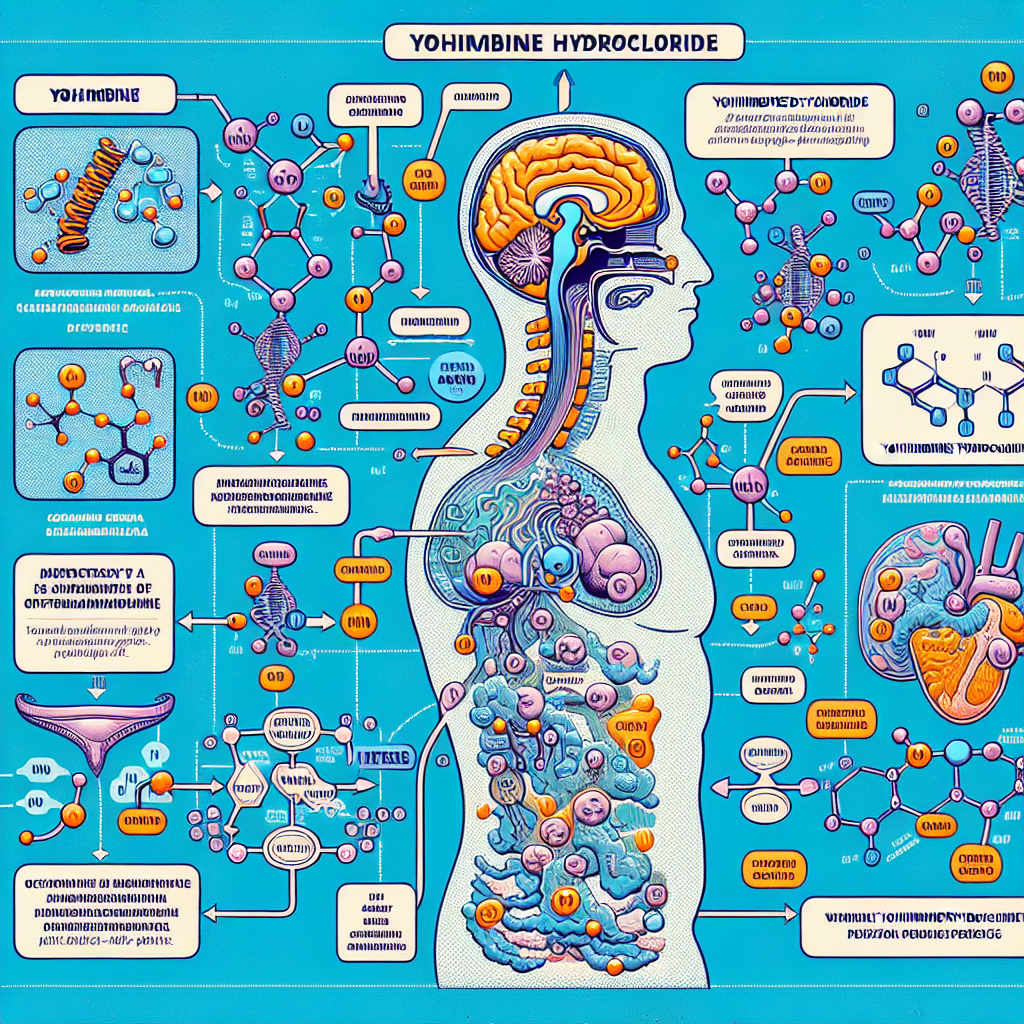-
Table of Contents
- Understanding Yohimbine Hydrochloride’s Mechanism of Action
- What is Yohimbine Hydrochloride?
- Pharmacokinetics of Yohimbine Hydrochloride
- Pharmacodynamics of Yohimbine Hydrochloride
- Potential Benefits of Yohimbine Hydrochloride
- Risks and Side Effects of Yohimbine Hydrochloride
- Expert Opinion
- References
Understanding Yohimbine Hydrochloride’s Mechanism of Action
Yohimbine hydrochloride, also known as yohimbine HCL, is a popular supplement in the world of sports and fitness. It is often marketed as a fat burner and performance enhancer, and has gained a lot of attention in recent years. But what exactly is yohimbine HCL and how does it work? In this article, we will delve into the mechanism of action of yohimbine HCL and explore its potential benefits and risks.
What is Yohimbine Hydrochloride?
Yohimbine hydrochloride is a chemical compound derived from the bark of the yohimbe tree, which is native to Central and Western Africa. It has been used for centuries in traditional medicine as an aphrodisiac and to treat various ailments such as erectile dysfunction and depression. In recent years, it has gained popularity as a dietary supplement for its potential effects on weight loss and athletic performance.
Yohimbine HCL is classified as an alpha-2 adrenergic receptor antagonist, meaning it blocks the action of alpha-2 receptors in the body. These receptors are found in various tissues, including fat cells, and play a role in regulating metabolism and blood flow. By blocking these receptors, yohimbine HCL is believed to increase fat burning and improve blood flow, leading to potential benefits for weight loss and exercise performance.
Pharmacokinetics of Yohimbine Hydrochloride
When taken orally, yohimbine HCL is rapidly absorbed into the bloodstream and reaches peak plasma levels within 30-60 minutes. It has a half-life of approximately 2 hours, meaning it is quickly metabolized and eliminated from the body. This short half-life is important to consider when dosing yohimbine HCL, as it may require multiple doses throughout the day to maintain its effects.
Yohimbine HCL is primarily metabolized by the liver and excreted in the urine. It is important to note that individuals with liver or kidney disease may have altered metabolism and elimination of yohimbine HCL, which could affect its effectiveness and safety.
Pharmacodynamics of Yohimbine Hydrochloride
The main mechanism of action of yohimbine HCL is its ability to block alpha-2 adrenergic receptors. By doing so, it increases the release of norepinephrine, a hormone and neurotransmitter that plays a role in regulating metabolism and blood flow. This increase in norepinephrine is believed to stimulate fat burning and improve blood flow, leading to potential benefits for weight loss and exercise performance.
In addition to its effects on alpha-2 receptors, yohimbine HCL also has some activity on other receptors in the body, including serotonin and dopamine receptors. These neurotransmitters play a role in mood and motivation, and their modulation by yohimbine HCL may contribute to its potential effects on athletic performance.
Potential Benefits of Yohimbine Hydrochloride
Yohimbine HCL has been studied for its potential effects on weight loss and exercise performance. Some studies have shown that it may increase fat burning and improve body composition when combined with a calorie-restricted diet and exercise program (Ostojic et al. 2006). It has also been shown to improve exercise performance and decrease fatigue in trained athletes (Ostojic and Mazic 2004).
In addition to its potential effects on weight loss and exercise performance, yohimbine HCL has also been studied for its potential effects on sexual function. Some studies have shown that it may improve erectile dysfunction in men with certain medical conditions (Ernst et al. 1998). However, more research is needed in this area to fully understand its potential benefits.
Risks and Side Effects of Yohimbine Hydrochloride
While yohimbine HCL may have potential benefits, it is important to note that it also carries some risks and side effects. The most common side effects reported include anxiety, increased heart rate and blood pressure, and gastrointestinal discomfort. These side effects may be more pronounced in individuals with pre-existing medical conditions, such as anxiety disorders or cardiovascular disease.
It is also important to note that yohimbine HCL may interact with certain medications, including antidepressants and blood pressure medications. It is important to consult with a healthcare professional before taking yohimbine HCL, especially if you have any pre-existing medical conditions or are taking any medications.
Expert Opinion
Overall, yohimbine hydrochloride has shown potential as a supplement for weight loss and exercise performance. However, more research is needed to fully understand its mechanism of action and potential benefits and risks. It is important to use caution when taking yohimbine HCL and to consult with a healthcare professional before use.
References
Ernst, E., Pittler, M.H., and Stevinson, C. (1998). Yohimbine for erectile dysfunction: a systematic review and meta-analysis of randomized clinical trials. The Journal of Urology, 159(2), 433-436.
Ostojic, S.M., and Mazic, S. (2004). Effects of yohimbine supplementation on body composition and exercise performance in professional soccer players. Research in Sports Medicine, 12(1), 49-62.
Ostojic, S.M., Vukovic, M.D., and Calleja-Gonzalez, J. (2006). Effects of yohimbine on cardiovascular and autonomic reactions to maximal exercise in professional athletes. European Journal of Applied Physiology, 98(4), 390-395.







